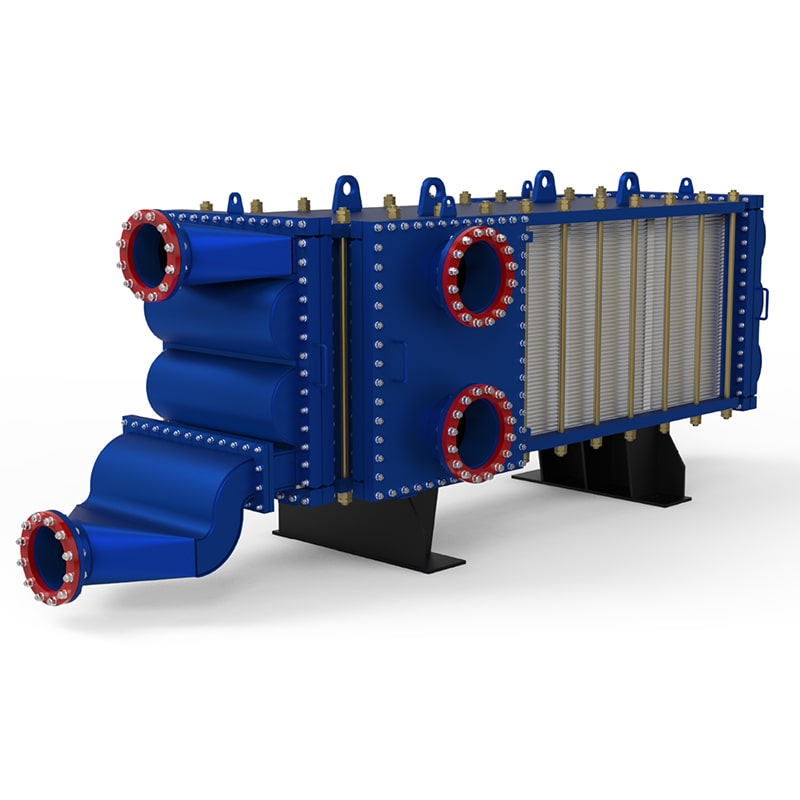Why Regular Heat Exchanger Service Matters for Industrial Efficiency
How Heat Exchanger Service Supports Industrial Efficiency

Role in Energy Transfer and Process Optimization
Heat exchangers play a central role in moving heat between fluids in industrial systems. When technicians perform heat exchanger service, they clean, inspect, and calibrate equipment. This process removes buildup and ensures that surfaces transfer heat efficiently. Clean surfaces allow fluids to reach target temperatures faster. Operators can then maintain steady production rates and avoid temperature fluctuations.
Process optimization depends on precise temperature control. Regular heat exchanger service helps companies achieve this control. Technicians identify early signs of fouling or scaling. They address these issues before they disrupt operations. As a result, production lines run smoothly, and product quality remains consistent.
Contribution to Cost Savings and Environmental Impact
Industrial facilities face high energy costs. Inefficient heat exchangers force systems to work harder, which increases utility bills. Routine heat exchanger service reduces this strain. Clean and well-maintained units use less energy to achieve the same results. Companies see lower operating costs and improved profit margins.
Environmental impact also improves with regular maintenance. Efficient heat transfer means less fuel consumption and fewer greenhouse gas emissions. Many industries must meet strict environmental regulations. Heat exchanger service supports compliance by keeping systems within required efficiency standards.
A quick comparison:
| Maintenance Level | Energy Use | Emissions | Cost |
|---|---|---|---|
| Regular Service | Low | Low | Reduced |
| Neglected Service | High | High | Increased |
By investing in heat exchanger service, companies protect both their bottom line and the environment.
Risks of Skipping Heat Exchanger Service
Efficiency Loss and Increased Energy Use
Neglecting heat exchanger service leads to a gradual decline in system efficiency. Dirt, scale, and other deposits build up on heat transfer surfaces. These layers act as insulation, making it harder for heat to move between fluids. As a result, equipment must work longer and harder to reach the desired temperatures. Operators notice higher energy consumption and longer processing times.
Facilities that ignore regular maintenance often see a spike in utility bills. The system compensates for lost efficiency by using more fuel or electricity. Over time, this increased energy use impacts both operational costs and environmental goals.
Escalating Maintenance and Repair Expenses
When companies skip scheduled maintenance, small issues can turn into major problems. Minor leaks or corrosion may go unnoticed until they cause significant damage. Emergency repairs cost more than planned service visits. Unplanned downtime disrupts production schedules and can lead to missed deadlines.
A comparison of maintenance approaches:
| Approach | Repair Costs | Downtime | Equipment Life |
|---|---|---|---|
| Regular Service | Low | Minimal | Extended |
| Skipped Service | High | Frequent | Shortened |
Facilities that invest in routine heat exchanger service avoid these costly surprises. They keep repair expenses predictable and protect valuable equipment.
Safety and Compliance Concerns
Industrial operations must follow strict safety and environmental regulations. Skipping heat exchanger service increases the risk of equipment failure. Leaks, pressure build-up, or overheating can create hazardous conditions for workers. Regulatory agencies may issue fines or shut down operations if they find non-compliance.
Benefits of Regular Heat Exchanger Service
Enhanced System Performance
Regular maintenance keeps heat exchangers operating at peak efficiency. Technicians remove deposits and inspect for early signs of wear. Clean surfaces allow for rapid and consistent heat transfer. Operators notice stable process temperatures and fewer fluctuations in product quality.
A well-serviced heat exchanger supports smooth workflow across the entire facility. Teams can rely on predictable system behavior, which improves coordination between different process stages. This reliability also makes it easier to meet customer demands and delivery schedules.
Lower Energy Consumption and Utility Costs
Facilities that invest in routine heat exchanger service see a direct impact on energy use. Clean equipment requires less energy to achieve the same level of heat transfer. Utility bills decrease as systems run more efficiently.
A simple comparison shows the difference:
| Condition | Energy Required | Utility Cost |
|---|---|---|
| Regularly Serviced | Lower | Reduced |
| Poorly Maintained | Higher | Increased |
Lower energy consumption also means less strain on other equipment. Pumps, boilers, and chillers do not need to work as hard. This benefit extends the life of supporting systems and reduces the risk of costly breakdowns.
Longer Equipment Lifespan
Routine heat exchanger service extends the life of critical assets. Technicians catch minor issues before they become major failures. Early detection of leaks, corrosion, or mechanical wear prevents expensive repairs and unplanned downtime.
A longer equipment lifespan means fewer replacements and less capital investment. Facilities can allocate resources to other priorities instead of emergency purchases.
Key advantages of longer lifespan:
·Reduced frequency of equipment replacement
·Lower long-term maintenance costs
·Improved return on investment
Regular service also supports compliance with manufacturer warranties. Many warranties require documented maintenance to remain valid. By following a service schedule, companies protect both their equipment and their financial interests.
Improved Regulatory Compliance and Safety
Industrial facilities must follow strict regulations to operate safely and avoid penalties. Regulatory agencies set standards for equipment performance, emissions, and workplace safety. Companies that ignore these rules risk fines, shutdowns, and damage to their reputation.
Regular heat exchanger service helps facilities meet these requirements. Technicians inspect equipment for leaks, corrosion, and pressure issues. They document each service visit and provide reports for compliance audits. These records show that the company takes safety and environmental standards seriously.
🛡️ Safety Tip: Routine inspections catch problems before they become hazards. Early detection prevents accidents and protects workers.
A well-maintained heat exchanger reduces the risk of dangerous failures. Leaks can release hazardous fluids or gases. Pressure build-up may cause explosions or fires. Technicians address these risks during each service visit. They replace worn parts and test safety controls.
Facilities also benefit from improved air quality and lower emissions. Clean heat exchangers operate efficiently and produce fewer pollutants. This helps companies meet environmental regulations and avoid costly violations.
A comparison of compliance outcomes:
| Maintenance Approach | Safety Incidents | Regulatory Fines | Audit Success Rate |
|---|---|---|---|
| Regular Service | Rare | Low | High |
| Neglected Service | Frequent | High | Low |
Companies that invest in heat exchanger service create a safer workplace. They build trust with regulators and protect their business from legal risks.
Common Problems Solved by Heat Exchanger Service

Fouling and Scaling Removal
Fouling and scaling often reduce the efficiency of heat exchangers. Minerals, dirt, and biological materials stick to internal surfaces. These deposits act as barriers, slowing down heat transfer. Technicians use specialized cleaning methods to remove these layers. They may use chemical solutions, high-pressure water jets, or mechanical brushes. Clean surfaces allow fluids to flow freely and transfer heat more effectively.
Facilities that address fouling early avoid sudden drops in efficiency. They also reduce the risk of unplanned shutdowns. Consistent service ensures that heat exchangers deliver reliable results every day.
Leak Detection and Repair
Leaks in heat exchangers can cause serious problems. Fluids may mix, leading to contamination or loss of product. Pressure drops can disrupt the entire process. Skilled technicians inspect joints, seals, and tubes for signs of leaks. They use pressure tests, dye penetrants, or ultrasonic devices to find even small leaks.
Once they find a leak, technicians repair or replace damaged parts. Fast action prevents further damage and keeps the system safe. Facilities that invest in regular leak checks avoid costly product loss and maintain process integrity.
Corrosion Prevention
Corrosion weakens metal surfaces inside heat exchangers. Moisture, chemicals, and high temperatures speed up this process. Over time, corrosion can cause holes or cracks. Technicians look for early signs of rust or pitting during service visits. They apply protective coatings or recommend material upgrades when needed.
A proactive approach to corrosion control extends equipment life. It also reduces the risk of leaks and unexpected breakdowns. Facilities that focus on corrosion prevention save money and avoid emergency repairs.
Best Practices for Effective Heat Exchanger Service
Setting a Maintenance Schedule
A well-planned maintenance schedule forms the backbone of effective heat exchanger service. Facility managers review manufacturer recommendations and operational demands to determine optimal service intervals. They often create a calendar that includes routine inspections, cleaning, and performance checks. This proactive approach prevents unexpected breakdowns and keeps equipment running smoothly.
Many companies use digital tools to track service dates and upcoming tasks. Automated reminders help teams stay organized and avoid missed appointments. Consistent scheduling ensures that technicians address minor issues before they escalate.
Selecting Qualified Service Providers
Choosing the right service provider impacts the quality of heat exchanger maintenance. Facility leaders evaluate providers based on experience, certifications, and industry reputation. They request references and review case studies to confirm expertise with specific heat exchanger models.
A comparison of provider qualifications:
| Criteria | Unqualified Provider | Qualified Provider |
|---|---|---|
| Certification | None | Industry-Recognized |
| Experience | Limited | Extensive |
| Safety Record | Poor | Excellent |
Qualified technicians follow safety protocols and use advanced diagnostic tools. They deliver thorough inspections and reliable repairs. Facilities that invest in skilled providers protect their assets and maintain compliance with regulations.
Ongoing Monitoring and Documentation
Continuous monitoring supports long-term efficiency and safety. Facility teams install sensors to track temperature, pressure, and flow rates. These devices alert operators to abnormal conditions, allowing for quick intervention.
Technicians record findings, repairs, and recommendations after every inspection. Managers review these records to identify trends and plan future upgrades. Accurate documentation also supports regulatory audits and warranty claims. Facilities that prioritize monitoring and recordkeeping maintain high standards and reduce operational risks.
Regular heat exchanger service supports industrial efficiency and keeps operations safe. Facilities that follow a maintenance schedule see fewer breakdowns and lower costs. Proactive care helps teams catch problems early and avoid expensive repairs. Companies that invest in routine service protect their equipment and meet industry standards. Reliable systems lead to better performance and long-term savings.
FAQ
How often should industrial facilities service heat exchangers?
Most facilities schedule service every 6 to 12 months. The exact interval depends on system usage, operating conditions, and manufacturer recommendations. Regular inspections help technicians catch problems early and maintain peak efficiency.
What signs indicate a heat exchanger needs maintenance?
Operators may notice reduced heat transfer, higher energy bills, or unusual noises. Leaks, pressure drops, or visible corrosion also signal the need for immediate service. Early detection prevents costly repairs.
Can regular service extend the life of a heat exchanger?
Yes. Routine cleaning, inspections, and timely repairs help prevent major failures. Facilities that follow a maintenance schedule often see equipment last several years longer than neglected units.
What methods do technicians use to clean heat exchangers?
Technicians use chemical cleaning, high-pressure water jets, or mechanical brushes. The method depends on the type of fouling and the heat exchanger’s design. Proper cleaning restores efficiency and prevents buildup.
Does heat exchanger service help with regulatory compliance?
Absolutely. Regular service ensures equipment meets safety and environmental standards. Technicians document each visit, which helps facilities pass audits and avoid fines.





